
Built by Baldwin in 1927, Santa Fe 3751 was the first 4-8-4 steam locomotive built for the railroad and was referenced in documentation as type "Heavy Mountain", "New Mountain", or "Mountain 4-wheel trailer". It holds the distinction of being the oldest surviving 4-8-4 type steam locomotive in the world.
When built, tests showed that the new locomotive was twenty percent more efficient and powerful than the 3700 class 4-8-2 Mountain types, which at the time were Santa Fe's most advanced steam locomotives. In 1936, the locomotive was converted to burn oil and was given a larger tender that holds 20,000 US gallons of water and 7,107 US gallons of fuel oil two years later. No. 3751 was also present at the grand opening of Union Passenger Terminal in Los Angeles on May 7, 1939, pulling the Scout, one of Santa Fe's premier passenger trains as it arrived from Chicago. It was the first steam locomotive to bring a passenger train into Union Station.
In 1941, 3751, along with the other 13 locomotives in its class, received major upgrades that included replacing the original 73 inch spoked driving wheels with 80 inch boxpok wheels, a new frame, Timken roller bearings on all axles and more. That same year, it achieved its highest recorded speed at 103 miles per hour. It continued to be a very reliable working locomotive until August 23, 1953, when it pulled the last regularly scheduled steam-powered passenger train on the Santa Fe to run between Los Angeles and San Diego; this was its last run in revenue service before being put into stored at the Redondo Junction and retired from active service. On May 14, 1958, it was placed on display in San Bernardino.
In 1981, the San Bernardino Railroad Historical Society was formed with intentions of restoring and operating 3751. Four years later, it achieved its goal when 3751 was sold to it for one cent with the condition that the SBRHS must restore and operate the locomotive. In 1986, 3751 was moved from its display to California Steel Industries, where it was restored at a cost of $1.50 million. On August 13, 1991, it moved under its own steam for the first time in thirty-eight years. It made its first excursion run on December 27, 1991, running with two Santa Fe EMD FP45s and 16 passenger cars on a four-day trip from Los Angeles via Barstow to Bakersfield. Since then, it has been utilized for a large number of excursions and special trips and for display at many events.
The locomotive is currently owned by the San Bernardino Railroad Historical Society, the same organization that performed the initial 1986 restoration. In August 1992, the 3751 was found on its largest assignment so far, as the engine ran the entire route of Santa Fe's Transcon route between Los Angeles and Chicago with three (and later two) Santa Fe GE Dash 8-40CWs. The engine spent 18 days travelling over 2,300 miles in both directions. This run would include travelling to Topeka, Kansas to attend that year's Topeka Railroad days, where the locomotive was briefly displayed near Union Pacific 4-6-6-4 3985.
On April 22–23, 1995, 3751 was displayed in the Riverside Sunkist Orange Blossom Festival in Riverside. On December 31, 1996 when Atchison, Topeka & Santa Fe merged with Burlington Northern Railroad to form Burlington Northern Santa Fe, the locomotive retained the same number. The excursion was operated again on April 20–21, 1996. In June 1999, the locomotive participated in Railfair '99. On the way to the fair, 3751, along with a BNSF Dash 9-44CW and mixed train of a tool car, ten BNSF boxcars and two passenger cars, from Los Angeles to Sacramento via San Bernardino, Barstow, Bakersfield, and Stockton. On the return trip to Los Angeles, the 3751 pulled another mixed train with several covered hoppers.
In October 2000, 3751 was listed on the National Register of Historic Places. It been displayed at Fullerton Railroad Days in Fullerton, California a number of times. In August 2002, 3751 operated an Amtrak excursion train from Los Angeles to Williams, Arizona to participate in the 2002 National Railway Historical Society convention and ran over Metrolink, BNSF and Arizona and California Railroad tracks. After arriving in Williams, the locomotive pulled some excursions and photo runbys on the Grand Canyon Railway between Williams and the Grand Canyon Village, including a doubleheader with GCR 2-8-2 4960 and a tripleheader with GCR 2-8-0 18. The steam engine also pulled some of GCR's Pullman passenger cars for a photo charter requested by Goodheart Productions.
In 2008, 3751 ran on the Surfline route for two excursions from Los Angeles to San Diego. The first on June 1 was a public excursion. The excursion made the locomotive the first steam locomotive to run on the Surf Line since the 1976 American Freedom Train, it was also the first steam powered passenger train to make the run between Los Angeles and San Diego since 3751 last travelled the line in 1953. The train was turned at Miramar Wye, 15 miles north of San Diego station. The second excursion was a private car special on September 21.
The Chase and RideWhen I heard Santa Fe 3751 was returning to San Diego, I decided to get a dome ticket for the first northbound daylight. Bob and Elizabeth decided to join me so plans were made where I would pick them up at the airport and take them to their hotel. We would chase the steam train to San Diego, stay the night, ride Santa Fe 3751 northbound and Chris Parker would chase both ways. I rented a Ford Focus and picked it up Friday afternoon then picked Bob and Elizabeth up at the Orange County Airport and brought them to my house. From there, we went to Orange to see a couple of trains then had dinner at The Habit. After that I checked them into the Red Roof Inn for the night and I returned home.
May 1, 2010I picked up Bob and Elizabeth before meeting Chris Parker at my house and we were off to our first stop in Anaheim.

The Anaheim Union Pacific station built 1923, and was in use as a YMCA.
Southern Pacfic wig-wag signal at the corner of Lemon Street and Santa Ana Street in Anaheim. This particular signal was featured in the 1922 Magnetic Signal Company catalogue.
Union Pacific power at Anaheim. From here we went to Fullerton.
A BNSF freight passing through Fullerton.

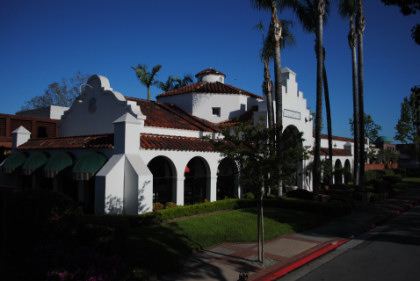
The former Fullerton Union Pacific station, built in 1923, now home to the Old Spaghetti Factory since 1974.
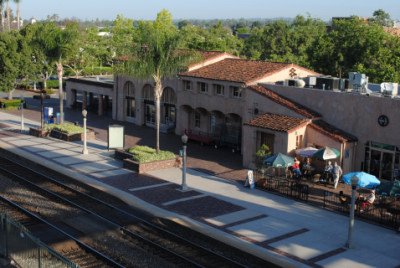
The active Fullerton station is the former Santa Fe station. From here we drove to Brea where we found the display locomotive for Brea Railroad Days.
An information sign on the display engine.
Union Pacific Yard 3GS21B 2745, one of the new Genset locomotives. From here we drove to La Habra for two railroad stations.
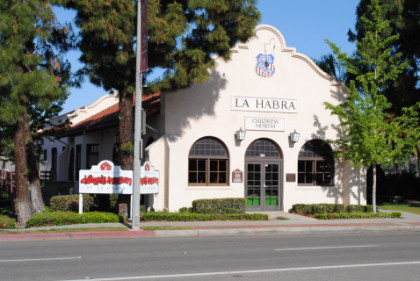
Union Pacific La Habra station built in 1923, now a children's museum.
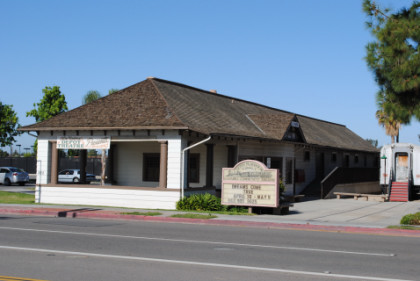
The former Pacific Electric station, which today is the La Habra Depot Playhouse Community Theater.
Both La Habra Stations in this view.
Another view of the Pacific Electric station.
The station sign on the Pacific Electric Station in La Habra.
Amtrak coach 5271, ex. Seaboard Coast Line 5271, nee Seaboard Air Line 6241 built by Budd Company in 1955.
Southern Pacific caboose 1165 built by the railroad in 1942.
Pacific Fruit Express boxcar 10418 built by the railroad in 1957.
Union Pacific box car 112018, builder and year unknown.
Southern Pacific box car 191960, builder and year unknown.
Southern Pacific box car 177381, builder and year unknown.
Steam engine and station photograph on a tarpaulin between the museum and theatre at La Habra.
A tank car at the other end of the musuem. From here we drove to Heritage Park in Santa Fe Springs.
Santa Fe 2-6-0 870, ex. Albuquerque and Los Cerrillos Coal 870 1940, exx. Rocky Mountain and Santa Fe 870 1915, nee St. Louis, Rocky Mountain and Pacific 101 built by Baldwin in 1906. Despite its sweeping name, the StLRM&P operated entirely in northern New Mexico, mainly serving the coal fields around Raton Pass. It was taken over by the AT&SF in 1913 and operated as a subsidiary. The Santa Fe changed the name to the Rocky Mountain & Santa Fe in 1915 and renumbered the locomotives 870-874. In 1940, the Santa Fe sold three 2-8-0s to the Albuquerque & Los Cerrillos Coal Company, which operated a coal mine in Madrid, New Mexico, connected by a branch line from the AT&SF at Waldo. As demand for coal fell off in the 1950's, however, the mine was shut and the branch line abandoned in 1959. 769 and 870 were left at Madrid sitting amid the remains of the mine operation. In 1989, the City of Santa Fe Springs acquired 870. The locomotive was restored to its post-1924 Santa Fe appearance and moved to the current location in Heritage Park.
View at Heritage Park.
Swift Refrigerator Line refrigerator car, number unknown, built by the company in the 1920's. The mural was painted by Mary McMenamin in 1995. We then drove to the grade crossing at Lakeland Street in Santa Fe Springs to wait for Santa Fe 3751 to arrive.
Pacific Surfliner 565 came first northbound.
This is the new National Train Day/Build a Better Breakfast Subway Car.
Pacific Surfliner 565 on its way to Los Angeles.
Next came Pacific Surfliner 768 heading south to San Diego. We heard 3751 call the BNSF track gang and soon saw smoke and its headlight.

Santa Fe 4-8-4 3751 passed under the old Santa Fe signal bridge at Lakeland Street.
The train bound for Fullerton to pick up more passengers. We returned to the car and drove to Interstate 5 and once in Orange County, took the carpool lane all the way to San Clemente, where we exited at Avendia Califia and parked down at the beach. After feeding the parking meter, we walked down along the tracks to our next photo location.
Bob Alkire called Let's Talk Trains as we waited until Santa Fe 3751 passed. We saw the smoke coming along the coast, then the signal went red and soon we saw Santa Fe 3751 approaching.
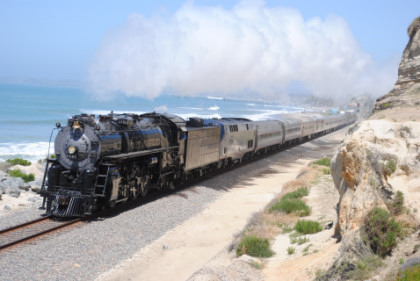
Santa Fe 3751 rolling south at Califia Beach.
The "Pony Express".
Amtrak conductor Bob Riskie, an excellent conductor who was now one week away from retiring and a good friend of mine.
The train heads south along the Pacific Ocean. After Bob and I put our feet in the Pacific Ocean, we had a green signal and waited for our next train.
Pacific Surfliner 571 on its way north to Los Angeles. From here, it was back on Interstate 5 which we took to Oceanside, where traffic forced me onto old Coast Highway which we took to Carlsbad and made another stop.
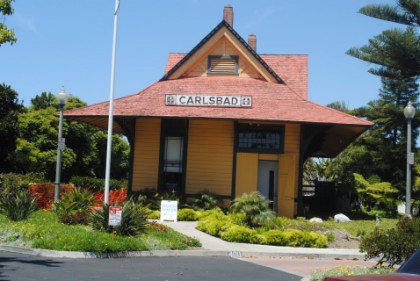
The former Santa Fe Carlsbad station built in 1887. From here we headed to Solana Beach to a Subway sandwich shop then drove to Torrey Pine State Park, parked then walked to our next photo location.
First a southbound Coaster train on its way to San Diego.
Interesting dripping on the cliff face across the tracks.
Next was Pacific Surfliner 774 heading to San Diego.
Santa Fe 3751 went by us at Torrey Pines State Beach just south of Del Mar.
Interesting plants. Feeling very satisfied, we walked back to the rental car and drove back north along the Coast Highway.

The former Santa Fe Del Mar station built in 1910.
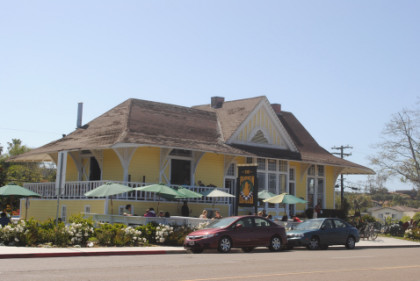
The former Santa Fe Encinitas station built in 1887. From here we headed to Oceanside to ride the Sprinter.
Pacific Surfliner 578 leaving Oceanside.
That Surfliner special painted car again.
Pacific Surfliner 583 coming into Oceanside.
The Sprinter then arrived and we boarded with Bob, Elizabeth and Chris Parker making their first trips on the Sprinter. We rode a round trip to Escondido and once back in Oceanside, used the facilities before taking another picture.
The display board at Oceanside Transportation Center. We returned to Interstate 5 and drove south to National City.
National City & Otay Mesa Horse Car 1 built by Hammond Car Works in 1887. It operated in the South Bay during the early years of this city. It wass part of the "Motor Cannon Ball" excursion train, the brainchild of National City founder Frank Kimball and the region's first commuter-type train dedicated to passengers rather than freight. Mr. Kimball used the train to bring prospective real-estate buyers to El Rancho de la Nacion, the land grant ranch that became National City. The train also provided popular excursions for visitors and tourists.
The NC&O traversed the South Bay from San Diego to the border and the Sweetwater Dam. Its route passed hills dotted with olive trees and stately Victorian homes, including Frank Kimball's famous Olivewood. A 60-mile round-trip ticket on the line was once advertised for just $1.00 -- the fare from National City to downtown San Diego -- 10 cents. This car was withdrawn from service in 1914 and restored to its 1880's appearance in 2000.
The historic plaque.
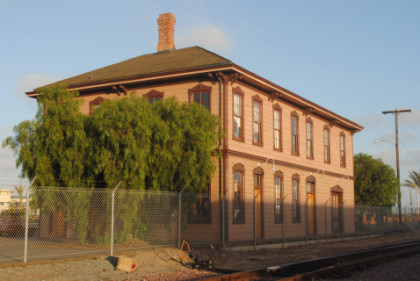
The former Santa Fe National City station constructed by the California Southern Railroad in 1882 which served to bring in new property owners and prosperity to the budding National City. The two-story building is still at the same location alongside the active Santa Fe (now BNSF) train tracks as it was originally. The San Diego Electric Railway Association operates and maintains the National City Depot Museum focusing on San Diego's rich streetcar and rail history. The building has been lovingly restored and our volunteers work to ensure that it will be around for generations to come.
Some of the trolleys here.
Billboard trolley. From here we drove to the South Bay Best Western and checked in then later, all went to the Black Angus for dinner before I returned to the room and wrote the story before calling it a night.